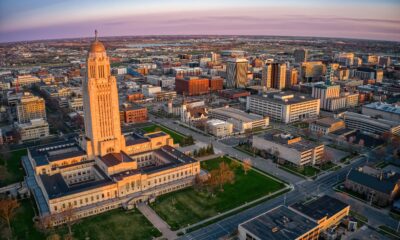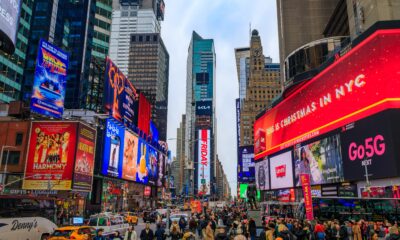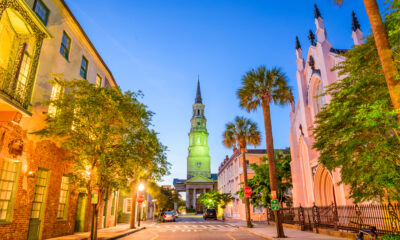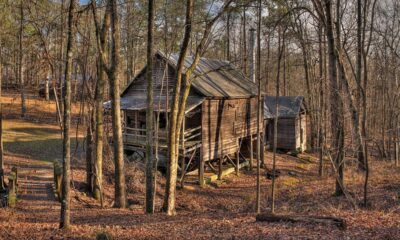Alabama
This four-story tower in Alabama witnessed the rise and fall of cotton slavery
Published
3 weeks agoon
By
Leo Heit
Kenworthy Hall
Edward Carlisle built his dream home on the backs of others.
After moving from Georgia in the 1830s with enslaved workers, he got rich as a cotton broker in Alabama’s Black Belt.
In 1858, he hired famed New York architect Richard Upjohn to create Kenworthy Hall, a grand Italian villa with a four-story tower.
During the Civil War, he even made more money, selling cotton at higher prices despite the Union blockade. But after 1865, his fortune crashed.
Farm values fell, and by 1867, his mansion was worth just $9,000.
The grand house near Marion still stands today, a beautiful yet troubling monument to wealth built through forced labor.

Cotton Trader Carlisle Left Georgia For Alabama’s Booming Black Belt
Edward Kenworthy Carlisle was born in 1810 near Augusta, Georgia.
His mother Susan moved them to Perry County, Alabama when Edward was young, bringing her enslaved workers along. They joined many ambitious cotton planters in Alabama’s fertile Black Belt region.
Several of Susan’s relatives already ran cotton plantations nearby, giving Edward helpful connections from the start. These family ties helped him enter the cotton business that made him rich.

Marriage Connected Him To Alabama’s Elite Planter Families
Around 1838, Carlisle started working as a cotton factor and merchant in Mobile. He sold cotton for planters and took a cut of the profits.
In 1841, he married Lucinda Wilson Walthall, linking him to some of Alabama’s oldest families. His in-laws John Walthall and Richard Booker Walthall helped him form valuable business partnerships.
Through his marriage and business skills, Carlisle bridged the gap between wealthy planters and merchants. His cotton trading business grew through these connections, building wealth for his future mansion.

New York Architect Brought Italian Style To Alabama Plantation
Carlisle hired popular New York architect Richard Upjohn in 1858 to design a grand home for his 440-acre plantation near Marion.
In his letters, Carlisle stressed he wanted “the finest materials and the best construction” money could buy. Upjohn adapted his Italian villa style for the hot Southern climate and plantation life.
The design featured a striking four-story tower unlike typical plantation homes.
The plans included practical touches like wide porches and a kitchen placed between the main house and slave quarters.

Finding Skilled Workers Proved Nearly Impossible In Rural Alabama
Building Kenworthy Hall turned into a two-year struggle. Carlisle couldn’t find workers skilled enough to build Upjohn’s complex designs in rural Alabama.
He ordered brownstone trim and other special materials shipped from New York, but many arrived broken. Master mason Philip Bond finally finished the difficult brickwork in June 1860 after many delays.
Costs grew as Carlisle stuck to Upjohn’s high standards despite the challenges. All this happened while enslaved people worked the cotton fields that paid for the fancy home.

Civil War Blockades Made Carlisle Even Richer
While many Southern planters struggled during the Civil War, Carlisle’s cotton trading company actually grew its profits.
In 1863, they sold 27 bales of cotton for 15 cents per pound, up from the prewar price of 11-12 cents. The Union naval blockade created shortages that drove up cotton prices.
Smugglers could make 300-500 percent profit per trip sneaking cotton to British islands. Carlisle’s trading skills let him profit from wartime conditions while other plantation owners lost money.
His business connections proved more valuable than ever during the war.

The Mansion’s Value Crashed To Just $9,000 After The War
The end of the Civil War brought financial ruin to Alabama’s plantation economy. Farm values across the state dropped from $226.6 million to just $73.1 million between 1865 and 1870.
Carlisle’s taxable property shrank to less than $20,000, a small fraction of his earlier wealth. Kenworthy Hall, which cost a fortune to build just years before, was worth only $9,000 in 1867.
This huge drop reflected a bigger economic change: Alabama farms recaptured less than 40% of their prewar value after slavery ended.

Banking Ventures In Selma Tried To Salvage Family Fortunes
Carlisle formed new business partnerships with his son Edward Jr. and son-in-law Alexander Jones after the war.
They created a merchant firm called Carlisle, Jones & Co. based in Selma.
The family also helped start City National Bank of Selma in 1871, trying to rebuild their wealth through banking rather than farming.
Between 1867 and 1870, Carlisle recorded seven deals for loans and mortgages worth thousands of dollars. These business moves showed his attempt to adjust to the postwar economy, but never restored his prewar wealth.

Lucinda Abandoned Kenworthy Hall After Her Husband Died
Edward Kenworthy Carlisle died in 1873, leaving his property to his wife Lucinda. She split her time between Kenworthy Hall and a home in Selma but mostly used the plantation mansion only in summer.
The grand house that showed the family’s status became too costly and impractical to keep as their main home. In 1899, Lucinda gave the property to her only living child, Augusta Carlisle Jones.
The house that once stood for Southern wealth now reminded them of lost fortune.

His Daughter Never Lived In The Mansion Full-Time
Augusta Jones owned a main home in Selma and never made Kenworthy Hall her permanent residence. Under her ownership, the mansion fell into bad shape from lack of care and regular upkeep.
After Lucinda died in 1912, Augusta sold the property in 1914, ending the Carlisle family’s tie to the house.
The mansion started to decline in the early 1900s as new owners lacked the money or interest to maintain such a large property.
The once-proud symbol of plantation wealth became just another aging building in rural Alabama.

Vandals Destroyed Marble Mantels And Stained Glass
The mansion suffered through several periods of complete vacancy, particularly during the 1950s when vandals caused extensive damage.
Intruders mutilated the plasterwork, broke marble mantels, and destroyed the stained glass windows. Local residents began spreading stories that the house was haunted, adding a supernatural element to its decline.
The vandalism reflected how far the property had fallen from its days as one of Alabama’s grandest homes.
Without regular care and security, the architectural masterpiece became a target for destruction and a source of ghost stories.

Upjohn’s Southern Plantation House Became A National Landmark
The Historic American Buildings Survey documented the mansion in 1934, recognizing its architectural significance despite its deteriorated condition.
Author Kathryn Tucker Windham featured the house and its supposed ghost in her book “13 Alabama Ghosts and Jeffrey,” bringing new attention to the property.
In 2004, Kenworthy Hall received National Historic Landmark status as the only surviving Richard Upjohn Italian villa adapted specifically for Southern plantation life.
The designation acknowledged the house as an important physical record of the antebellum cotton economy built on enslaved labor, preserving the story of Carlisle’s rise and fall.

Visiting Kenworthy Hall, Alabama
Kenworthy Hall is a National Historic Landmark on Alabama Highway 14, two miles west of Marion’s courthouse square.
This private residence has limited public access, so you’ll typically need to view it from the road via the private driveway.
The original brick house features brownstone trim shipped from New York, plus you can see the detached brick kitchen and other plantation buildings on the grounds.
Contact the owners ahead of time for any special access arrangements.
This article was created with AI assistance and human editing.
Read more from this brand:
Currently residing in Phoenix, Arizona with his wife and Pomeranian, Mochi. Leo is a lover of all things travel related outside and inside the United States. Leo has been to every continent and continues to push to reach his goals of visiting every country someday. Learn more about Leo on Muck Rack.


Here Are 12 Things People from West Virginia Do That Seem Insane To Everyone Else

Here Are 12 Things People from Washington Do That Seem Insane To Everyone Else

Here Are 12 Things People from Virginia Do That Seem Insane To Everyone Else

New Mexico Albuquerque International Balloon Fiesta wrap-ups and fall arts

Mississippi Natchez Trace fall festivals and music events

12 Reasons Why You Should Never Ever Move to Florida

Best national parks for a quiet September visit

In 1907, Congress forced Roosevelt to put God back on U.S. coins. Here’s why.

The radioactive secret White Sands kept from New Mexicans for 30 years

America’s most famous railroad photo erased 12,000 Chinese workers from history
Trending Posts

 Pennsylvania3 days ago
Pennsylvania3 days agoHere Are 12 Things People from Pennsylvania Do That Seem Insane To Everyone Else

 North Carolina4 days ago
North Carolina4 days agoHere Are 12 Things People from North Carolina Do That Seem Insane To Everyone Else

 Nebraska6 days ago
Nebraska6 days agoHere Are 12 Things People from Nebraska Do That Seem Insane To Everyone Else

 Maine5 days ago
Maine5 days agoThe ruins of a town that time forgot are resting in this Maine state park

 New York4 days ago
New York4 days agoHere Are 12 Things People from New York Do That Seem Insane To Everyone Else

 South Carolina2 days ago
South Carolina2 days agoHere Are 12 Things People from South Carolina Do That Seem Insane To Everyone Else

 Ohio4 days ago
Ohio4 days agoHere Are 12 Things People from Ohio Do That Seem Insane To Everyone Else

 Georgia5 days ago
Georgia5 days agoThis plantation’s slave quarters tell Georgia’s slowest freedom story
